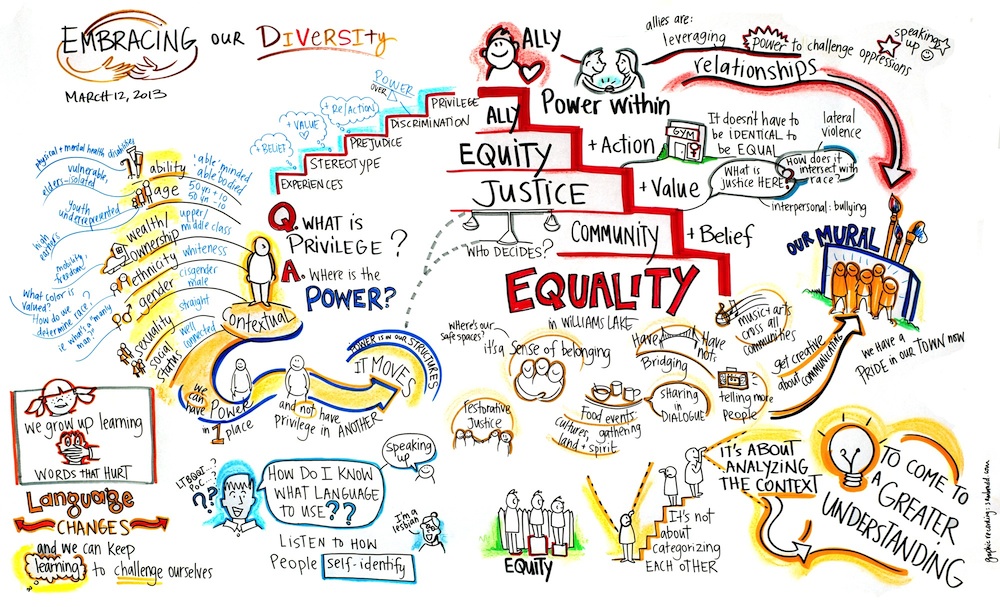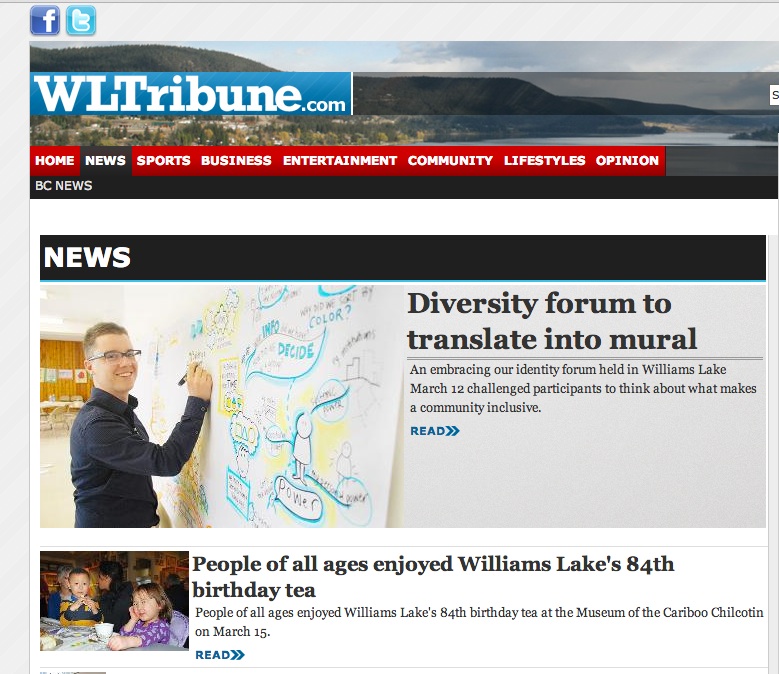Embracing Diversity – graphic recording and dialogue
The Fraser Basin Council in Williams Lake hosted a forum on diversity, multiculturalism and anti-racism. I brought graphic recording to support their discussion and dialogue.
This diversity forum covered a lot of ground. Participants talked about vocabulary and ‘words that hurt’. Iris from PeerNet BC facilitated great discussions about systems of power and privilege that intersect in our lives and affect people differently. Lots of group work to get people talking with each other. Another beautiful and unique thing about this forum – the walls were filled with anti-racism posters made by elementary school classes, and there was youth participation (including some homeschoolers). The youth presence grounded for me why we do this work.
I noticed a few things about bringing graphic recording into an forum about building an inclusive community.
In this context, the graphic recording visual is also a piece of art that honours the important work of this gathering. I’m not there to make talking about racism ‘beautiful’ – but I am there to show that tackling our shared problems together can be a place of hope. Seeing the result of a day-long dialogue is empowering: the graphic recording maps out how much we covered. It’s a way for participants to carry that conversation forward into their homes and groups – ‘let me show you what we talked about.’
Secondly, it was helpful to expand on the facilitator’s diagrams with pictures. In one facilitated exercise, Iris drew a diagram on her end of the wall and talked the participants through it (the staircase diagram below). People were really engaged and connected with her diagram. On my end of the wall, I supported the group by redrawing it and synthesizing the information with pictures. I could incorporate the examples the group found helpful and make connections to their work from earlier in the day. Both diagrams are needed: examples don’t make sense without a template and vice versa.
 Finally, I wonder if having the big visuals was an outlet for emotional learners. Anti-racism work can challenge peoples’ world views and this can get emotional. Sometimes, members of groups with privilege can be defensive which affects the groups’ ability to move forward. In any setting, graphic recording can help people see different parts of ‘the big picture’ and how different pieces of information fit together. In this diversity forum, I wonder if the images on the wall validated some of the tensions and emotions that people expressed. The pictures can capture a groups’ questions, and curiosity. Things can be undefined. The wall became a gathering place at lunch and at breaks, and I noticed people talking with each other about what had been said – by using the pictures. Not everyone likes having tough conversations with eye contact – sometimes looking at something together can be easier!
Finally, I wonder if having the big visuals was an outlet for emotional learners. Anti-racism work can challenge peoples’ world views and this can get emotional. Sometimes, members of groups with privilege can be defensive which affects the groups’ ability to move forward. In any setting, graphic recording can help people see different parts of ‘the big picture’ and how different pieces of information fit together. In this diversity forum, I wonder if the images on the wall validated some of the tensions and emotions that people expressed. The pictures can capture a groups’ questions, and curiosity. Things can be undefined. The wall became a gathering place at lunch and at breaks, and I noticed people talking with each other about what had been said – by using the pictures. Not everyone likes having tough conversations with eye contact – sometimes looking at something together can be easier!
The forum is the first activity in a series: the larger project is an outdoor mural designed by the community and coordinated by local artist Dwayne Davis. As the forum promotional materials said, “Participation in community art projects builds bonds between all ages, backgrounds and ethnicities,” says Maureen LeBourdais, FBC Regional Manager for the Cariboo Chilcotin. “A community whose members are engaged with each other is more likely to be safer, healthier, more environmentally sustainable and economically stronger.”
Williams Lake has lots going on – I learned about a multicultural cookbook project, a new youth drop in, and an upcoming Truth and Reconciliation event in May. People are resilient and resourceful – and I can’t wait to go back and visit again (maybe when there’s less snow and more sun!).
The forum made the front page of the paper on March 18, too (online version below).

(post edited Mar 19 for clarity)

One comment on “Embracing Diversity – graphic recording and dialogue”
Sam, thank you for the stellar work you did on this project. As you say, it can be easier for people to talk about their experiences when they have a concrete image to refer to. I am looking forward to looking at the images you created and integrating them with my memories of the event itself.
There is always more work to be done, and more dialogue to engage in, but this was a fascinating step along the way!